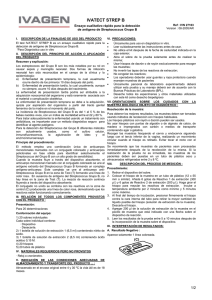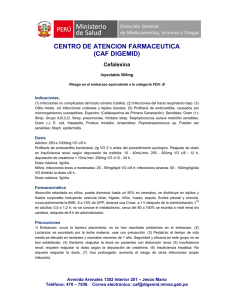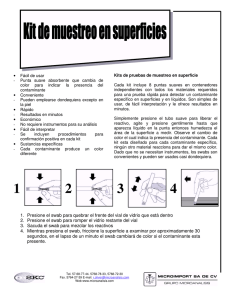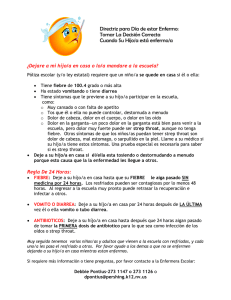Fisher Healthcare Sure-Vue Strep A Moderately Complex Instruction
Anuncio
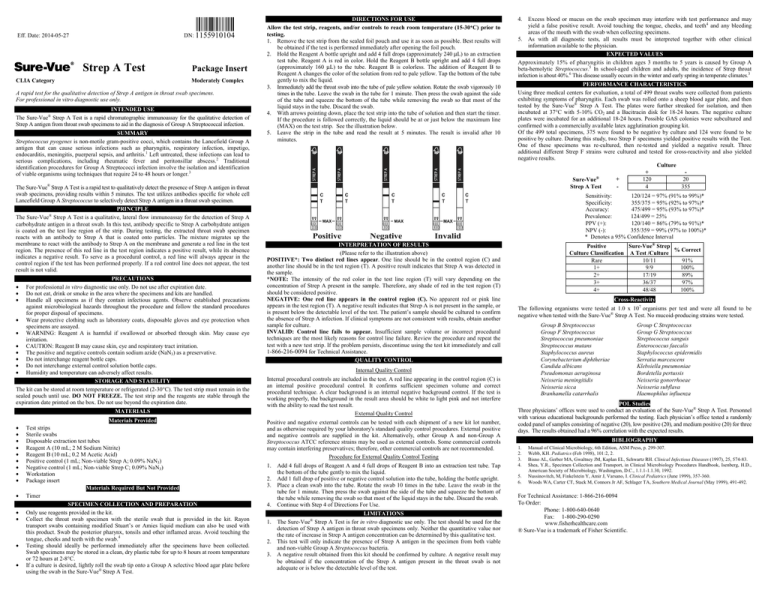
DN: 1155910104 Eff. Date: 2014-05-27 Strep A Test CLIA Category Package Insert Moderately Complex A rapid test for the qualitative detection of Strep A antigen in throat swab specimens. For professional in vitro diagnostic use only. INTENDED USE The Sure-Vue® Strep A Test is a rapid chromatographic immunoassay for the qualitative detection of Strep A antigen from throat swab specimens to aid in the diagnosis of Group A Streptococcal infection. SUMMARY Streptococcus pyogenes is non-motile gram-positive cocci, which contains the Lancefield Group A antigen that can cause serious infections such as pharyngitis, respiratory infection, impetigo, endocarditis, meningitis, puerperal sepsis, and arthritis.1 Left untreated, these infections can lead to serious complications, including rheumatic fever and peritonsillar abscess.2 Traditional identification procedures for Group A Streptococci infection involve the isolation and identification of viable organisms using techniques that require 24 to 48 hours or longer.3 The Sure-Vue® Strep A Test is a rapid test to qualitatively detect the presence of Strep A antigen in throat swab specimens, providing results within 5 minutes. The test utilizes antibodies specific for whole cell Lancefield Group A Streptococcus to selectively detect Strep A antigen in a throat swab specimen. PRINCIPLE The Sure-Vue® Strep A Test is a qualitative, lateral flow immunoassay for the detection of Strep A carbohydrate antigen in a throat swab. In this test, antibody specific to Strep A carbohydrate antigen is coated on the test line region of the strip. During testing, the extracted throat swab specimen reacts with an antibody to Strep A that is coated onto particles. The mixture migrates up the membrane to react with the antibody to Strep A on the membrane and generate a red line in the test region. The presence of this red line in the test region indicates a positive result, while its absence indicates a negative result. To serve as a procedural control, a red line will always appear in the control region if the test has been performed properly. If a red control line does not appear, the test result is not valid. PRECAUTIONS • For professional in vitro diagnostic use only. Do not use after expiration date. • Do not eat, drink or smoke in the area where the specimens and kits are handled. • Handle all specimens as if they contain infectious agents. Observe established precautions against microbiological hazards throughout the procedure and follow the standard procedures for proper disposal of specimens. • Wear protective clothing such as laboratory coats, disposable gloves and eye protection when specimens are assayed. • WARNING: Reagent A is harmful if swallowed or absorbed through skin. May cause eye irritation. • CAUTION: Reagent B may cause skin, eye and respiratory tract irritation. • The positive and negative controls contain sodium azide (NaN3) as a preservative. • Do not interchange reagent bottle caps. • Do not interchange external control solution bottle caps. • Humidity and temperature can adversely affect results. STORAGE AND STABILITY The kit can be stored at room temperature or refrigerated (2-30°C). The test strip must remain in the sealed pouch until use. DO NOT FREEZE. The test strip and the reagents are stable through the expiration date printed on the box. Do not use beyond the expiration date. MATERIALS • • • • • • • • • • • • • • Materials Provided Test strips Sterile swabs Disposable extraction test tubes Reagent A (10 mL; 2 M Sodium Nitrite) Reagent B (10 mL; 0.2 M Acetic Acid) Positive control (1 mL; Non-viable Strep A; 0.09% NaN3) Negative control (1 mL; Non-viable Strep C; 0.09% NaN3) Workstation Package insert Materials Required But Not Provided Timer SPECIMEN COLLECTION AND PREPARATION Only use reagents provided in the kit. Collect the throat swab specimen with the sterile swab that is provided in the kit. Rayon transport swabs containing modified Stuart’s or Amies liquid medium can also be used with this product. Swab the posterior pharynx, tonsils and other inflamed areas. Avoid touching the tongue, cheeks and teeth with the swab.4 Testing should ideally be performed immediately after the specimens have been collected. Swab specimens may be stored in a clean, dry plastic tube for up to 8 hours at room temperature or 72 hours at 2-8°C. If a culture is desired, lightly roll the swab tip onto a Group A selective blood agar plate before using the swab in the Sure-Vue® Strep A Test. DIRECTIONS FOR USE Allow the test strip, reagents, and/or controls to reach room temperature (15-30°C) prior to testing. 1. Remove the test strip from the sealed foil pouch and use it as soon as possible. Best results will be obtained if the test is performed immediately after opening the foil pouch. 2. Hold the Reagent A bottle upright and add 4 full drops (approximately 240 µL) to an extraction test tube. Reagent A is red in color. Hold the Reagent B bottle upright and add 4 full drops (approximately 160 µL) to the tube. Reagent B is colorless. The addition of Reagent B to Reagent A changes the color of the solution from red to pale yellow. Tap the bottom of the tube gently to mix the liquid. 3. Immediately add the throat swab into the tube of pale yellow solution. Rotate the swab vigorously 10 times in the tube. Leave the swab in the tube for 1 minute. Then press the swab against the side of the tube and squeeze the bottom of the tube while removing the swab so that most of the liquid stays in the tube. Discard the swab. 4. With arrows pointing down, place the test strip into the tube of solution and then start the timer. If the procedure is followed correctly, the liquid should be at or just below the maximum line (MAX) on the test strip. See the illustration below. 5. Leave the strip in the tube and read the result at 5 minutes. The result is invalid after 10 minutes. 4. Excess blood or mucus on the swab specimen may interfere with test performance and may yield a false positive result. Avoid touching the tongue, cheeks, and teeth4 and any bleeding areas of the mouth with the swab when collecting specimens. 5. As with all diagnostic tests, all results must be interpreted together with other clinical information available to the physician. EXPECTED VALUES Approximately 15% of pharyngitis in children ages 3 months to 5 years is caused by Group A 5 beta-hemolytic Streptococcus. In school-aged children and adults, the incidence of Strep throat infection is about 40%.6 This disease usually occurs in the winter and early spring in temperate climates.3 PERFORMANCE CHARACTERISTICS Using three medical centers for evaluation, a total of 499 throat swabs were collected from patients exhibiting symptoms of pharyngitis. Each swab was rolled onto a sheep blood agar plate, and then tested by the Sure-Vue® Strep A Test. The plates were further streaked for isolation, and then incubated at 37°C with 5-10% CO2 and a Bacitracin disk for 18-24 hours. The negative culture plates were incubated for an additional 18-24 hours. Possible GAS colonies were subcultured and confirmed with a commercially available latex agglutination grouping kit. Of the 499 total specimens, 375 were found to be negative by culture and 124 were found to be positive by culture. During this study, two Strep F specimens yielded positive results with the Test. One of these specimens was re-cultured, then re-tested and yielded a negative result. Three additional different Strep F strains were cultured and tested for cross-reactivity and also yielded negative results. Culture + 120 20 + Sure-Vue® Strep A Test 4 355 Sensitivity: 120/124 = 97% (91% to 99%)* Specificity: 355/375 = 95% (92% to 97%)* Accuracy: 475/499 = 95% (93% to 97%)* Prevalence: 124/499 = 25% PPV (+): 120/140 = 86% (79% to 91%)* NPV (-): 355/359 = 99% (97% to 100%)* * Denotes a 95% Confidence Interval INTERPRETATION OF RESULTS (Please refer to the illustration above) POSITIVE*: Two distinct red lines appear. One line should be in the control region (C) and another line should be in the test region (T). A positive result indicates that Strep A was detected in the sample. *NOTE: The intensity of the red color in the test line region (T) will vary depending on the concentration of Strep A present in the sample. Therefore, any shade of red in the test region (T) should be considered positive. NEGATIVE: One red line appears in the control region (C). No apparent red or pink line appears in the test region (T). A negative result indicates that Strep A is not present in the sample, or is present below the detectable level of the test. The patient’s sample should be cultured to confirm the absence of Strep A infection. If clinical symptoms are not consistent with results, obtain another sample for culture. INVALID: Control line fails to appear. Insufficient sample volume or incorrect procedural techniques are the most likely reasons for control line failure. Review the procedure and repeat the test with a new test strip. If the problem persists, discontinue using the test kit immediately and call 1-866-216-0094 for Technical Assistance. QUALITY CONTROL Internal Quality Control Internal procedural controls are included in the test. A red line appearing in the control region (C) is an internal positive procedural control. It confirms sufficient specimen volume and correct procedural technique. A clear background is an internal negative background control. If the test is working properly, the background in the result area should be white to light pink and not interfere with the ability to read the test result. External Quality Control Positive and negative external controls can be tested with each shipment of a new kit lot number, and as otherwise required by your laboratory's standard quality control procedures. External positive and negative controls are supplied in the kit. Alternatively, other Group A and non-Group A Streptococcus ATCC reference strains may be used as external controls. Some commercial controls may contain interfering preservatives; therefore, other commercial controls are not recommended. Procedure for External Quality Control Testing 1. Add 4 full drops of Reagent A and 4 full drops of Reagent B into an extraction test tube. Tap the bottom of the tube gently to mix the liquid. 2. Add 1 full drop of positive or negative control solution into the tube, holding the bottle upright. 3. Place a clean swab into the tube. Rotate the swab 10 times in the tube. Leave the swab in the tube for 1 minute. Then press the swab against the side of the tube and squeeze the bottom of the tube while removing the swab so that most of the liquid stays in the tube. Discard the swab. 4. Continue with Step 4 of Directions For Use. LIMITATIONS 1. The Sure-Vue® Strep A Test is for in vitro diagnostic use only. The test should be used for the detection of Strep A antigen in throat swab specimens only. Neither the quantitative value nor the rate of increase in Strep A antigen concentration can be determined by this qualitative test. 2. This test will only indicate the presence of Strep A antigen in the specimen from both viable and non-viable Group A Streptococcus bacteria. 3. A negative result obtained from this kit should be confirmed by culture. A negative result may be obtained if the concentration of the Strep A antigen present in the throat swab is not adequate or is below the detectable level of the test. Positive Sure-Vue® Strep % Correct Culture Classification A Test /Culture Rare 10/11 91% 1+ 9/9 100% 2+ 17/19 89% 3+ 36/37 97% 4+ 48/48 100% Cross-Reactivity The following organisms were tested at 1.0 x 107 organisms per test and were all found to be negative when tested with the Sure-Vue® Strep A Test. No mucoid-producing strains were tested. Group B Streptococcus Group F Streptococcus Streptococcus pneumoniae Streptococcus mutans Staphylococcus aureus Corynebacterium diphtheriae Candida albicans Pseudomonas aeruginosa Neisseria meningitidis Neisseria sicca Branhamella catarrhalis Group C Streptococcus Group G Streptococcus Streptococcus sanguis Enterococcus faecalis Staphylococcus epidermidis Serratia marcescens Klebsiella pneumoniae Bordetella pertussis Neisseria gonorrhoeae Neisseria subflava Haemophilus influenza POL Studies Three physicians’ offices were used to conduct an evaluation of the Sure-Vue® Strep A Test. Personnel with various educational backgrounds performed the testing. Each physician’s office tested a randomly coded panel of samples consisting of negative (20), low positive (20), and medium positive (20) for three days. The results obtained had a 96% correlation with the expected results. BIBLIOGRAPHY 1. 2. 3. 4. 5. 6. Manual of Clinical Microbiology, 6th Edition, ASM Press, p. 299-307. Webb, KH. Pediatrics (Feb 1998), 101:2, 2. Bisno AL, Gerber MA, Gwaltney JM, Kaplan EL, Schwartz RH. Clinical Infectious Diseases (1997), 25, 574-83. Shea, Y.R., Specimen Collection and Transport, in Clinical Microbiology Procedures Handbook, Isenberg, H.D., American Society of Microbiology, Washington, D.C., 1.1.1-1.1.30, 1992. Nussinovitch, M, Finkelstein Y, Amir J, Varsano, I. Clinical Pediatrics (June 1999), 357-360. Woods WA, Carter CT, Stack M, Connors Jr AF, Schlager TA, Southern Medical Journal (May 1999), 491-492. For Technical Assistance: 1-866-216-0094 To Order: Phone: 1-800-640-0640 Fax: 1-800-290-0290 www.fisherhealthcare.com ® Sure-Vue is a trademark of Fisher Scientific. Número: 1155910104 Fecha efectiva: 2014-05-27 Prueba Strep A CLIA Category Ficha Técnica Moderately Complex Prueba rápida para la detección cualitativa del antígeno Strep A en muestras de frotis de garganta. Solo para uso profesional de diagnóstico in vitro. USO INDICADO La Prueba Sure-Vue® Strep A es un inmunoensayo cromatográfico para la detección cualitativa del antígeno Strep A a partir del frotis de garganta para ayudar en el diagnóstico de las infecciones de Estreptocócico del Grupo A. RESUMEN El Estreptococo pyogenes es un gram positivo coccí no movible, el cual contiene el antígeno del Grupo A Lancefield, el cual causa infecciones severas tales como faringitis, infecciones respiratorias, impetigo, endocarditis, meningitis, sepsis puerperal y artritis.1 Si estas infecciones no se tratan pueden conducir a complicaciones severas incluyendo fiebre reumática y abscesos peritonsilares.2 Los procedimientos de identificación tradicional para las infecciones de estreptococo del Grupo A, involucran el aislamiento e identificación de organismos viables utilizando técnicas que requieren de 24 a 48 horas o más.3 La Prueba Sure-Vue® Strep A es una prueba rápida para la detección cualitativa del antígeno Strep A en muestras de frotis de garganta dando resultados en 5 minutos. La prueba utiliza anticuerpos específicos para las células totales del Estreptococo Grupo A Lancefield para, selectivamente detectar el antígeno Strep A en las muestras de frotis de garganta. PRINCIPIO O La Prueba Sure-Vue® Strep A es un inmunoensayo cualitativo de flujo lateral para la detección del antígeno carbohidrato Strep A en frotis de garganta. En esta prueba, el anticuerpo específico para el antígeno carbohidrato Strep A está recubierto sobre la región de la línea de prueba de la tira. Después de que la tira de prueba es sumergida dentro de la muestra, las muestras extractadas de frotis de garganta reaccionan con un anticuerpo para Strep A que está recubierto sobre partículas. La mezcla migra hacia la membrana para reaccionar con el anticuerpo del Strep A sobre la membrana y generar una línea coloreada en la región de la línea de prueba. La presencia de esa línea coloreada en la región de la línea de prueba indica un resultado positivo, mientras que la ausencia indica un resultado negativo. Como control del procedimiento la línea coloreada siempre aparecerá en la región de la línea de control si la prueba ha sido realizada correctamente. Si la línea de control coloreada no aparece, los resultados no son válidos. PRECAUCIONES • Solo para uso profesional de diagnóstico in vitro. No se utilice después de su fecha de vencimiento. • No comer, beber o fumar en el área mientras las muestras y los estuches están siendo manipulados. • Manipular todas las muestras como si contuvieran agentes infecciosos. Observe las precauciones establecidas contra los riesgos microbiológicos y siga los procedimientos estándares establecidos para el desecho adecuado de las muestras. • Utilice la ropa adecuada, tal como batas de laboratorio, guantes desechables, y protección para los ojos cuando las muestras estén siendo utilizadas. • ADVERTENCIA: El reactivo A es prejudicial si es tragado o absorbido por la piel. Puede causar irritación en los ojos. • PRECAUCION: El Reactivo B puede causar irritaciónes en la piel, en los ojos o en las vías respiratorias. • Los controles positivos y negativos contienen Azida Sódica (NaN3) como preservativo. • No intercambie las tapas de las botellas de los reactivos. • No intercambie las tapas de las botellas de los controles externos. • La humedad y la temperatura pueden afectar los resultados. ALMACENAMIENTO Y ESTABILIDAD Almacene el empaque sellado ya sea a temperatura ambiente o refrigerado entre 2-30°C. La tira de prueba y los reactivos son estables hasta la fecha de vencimiento que se encuentra en el estuche sellado. La tira debe permanecer sellada hasta que ser utilizada. NO CONGELAR. No debe utilizarse después de la fecha de vencimiento. MATERIALES Materiales Suministrados • • • • • • • • • • • • • Tiras Torundas estériles Tubos de extracción Reactivo A (10 mL; 2 M Nitrato de Sodio) Reactivo B (10 mL; 0,2 M Ácido Acético) Control Positivo (1 mL; Strep A No viable; 0,09% NaN3) Control Negativo (1 mL; Strep C No viable; 0,09% NaN3) Ficha técnica Estación de trabajo Materiales Requeridos no Suministrados Cronómetro OBTENCIÓN Y PREPARACION DE LA MUESTRA Recolecte las muestras de frotis de garganta con el copito de dacrón estéril que provee el estuche. Esponjas del transporte del rayón que contienen Stuart modificado o el medio líquido de Amies se puede también utilizar con este producto. Frote la faringe posterior, amígdalas y otras áreas inflamadas. Evite tocar la lengua, la parte interna de los pómulos y los dientes con el copito.4 La prueba debe ser realizada inmediatamente después de que las muestras han sido recolectadas. Las muestras del copito pueden almacenarse en un tubo plástico seco y limpio hasta por 8 horas a temperatura ambiente o por 72 horas a una temperatura de 2-8°C. • Si se desea realizar un cultivo, ruede ligeramente la punta del copito de dacrón para toma de muestra faríngea sobre un agar de sangre GAS de Grupo Selectivo A antes de ser utilizado el copito en La Prueba Sure-Vue® Strep A. INSTRUCCIONES DE USO Deje que la tira de prueba, reactivos, y/o controles alcancen a la temperatura ambiente (1530°C) antes de realizar la prueba. 1. Permita que el empaque alcance la temperatura ambiente antes de abrirlo. Extraiga la tira de prueba del empaque y úselo tan pronto como sea posible. 2. Sujete la botella del Reactivo A verticalmente, agregue cuatro 4 gotas completas (aproximadamente 240 µl) a un tubo de ensayo de extracción. El Reactivo A tiene color rojo. Sujete la botella del reactivo B verticalmente y agregue cuatro 4 gotas completas (aproximadamente 160 µl) al tubo de extracción. El reactivo B no tiene color. Mezcle las soluciones agitando suavemente el tubo de extracción. La adición del Reactivo B al reactivo A cambia el color de la solución de Rojo a Amarillo. 3. Inmediatamente agregue el frotis de garganta al tubo de ensayo de extracción de la solución amarilla. Gire el bastoncillo enérgicamente 10 veces dentro del tubo. Deje la torunda en el tubo de extracción por un 1 minuto. Entonces presione la torunda contra el lado del tubo para exprimir la parte inferior del tubo mientras retira la torunda. Deseche la torunda. 4. Con las flechas apuntando hacia la muestra, coloque la tira verticalmente en la solución de muestra extractada y ponga en marcha el crónometro. Si sigue el procedimiento correctamente la solución de extracción no debe pasar más de la línea máxima (MAX) sobre la tira cuando la franja esté inmersa. 5. Deje la tira en el tubo y lea el resultado transcurridos 5 minutos. El resultado no será válido transcurridos 10 minutos. 3. Un resultado negativo debe ser confirmado conun cultivo. Un resultado negativo se puede obtener si la concentración del antígeno Strep A presente en el frotis de garganta no es adecuada o se encuentra en niveles mas bajos que la sensibilidad de la prueba. 4. El exceso de sangre o moco en la muestra de la torunda puede interferir con la realización de la prueba y puede conducir a resultados falso positivo. Evite tocar la lengua, mejillas o dientes4 y cualquier área de sangrado de la boca con la torunda cuando esté recolectando las muestras. 5. Como en todas las pruebas de diagnóstico, los resultados deben ser interpretados junto con la información clínica disponible al médico. VALORES ESPERADOS Aproximadamente el 15% de los casos de faringitis en niños cuyas edades son de 3 meses a 5 años son causadas por el Estreptococo Beta-hemolítico Grupo A.5 En niños de edades escolares y en adultos la frecuencia de la infección de garganta Strep, es alrededor del 40%.6 Esta enfermedad normalmente ocurre en verano y en el inicio de la primavera en climas templados.3 CARACTERISTICAS TÉCNICAS Sensibilidad y Especificidad Se utilizaron tres centros médicos como laboratorios de referencia para la evaluación, un total de 499 frotis de garganta fueron recolectadas de pacientes que exhibían síntomas de faringitis. Cada torunda de dacrón fue enrollada sobre una placa de Agar de sangre (GAS) de grupo A selectivo y después se realizo con La Prueba Sure-Vue® Strep A. Las placas, posteriormente fueron ralladas para su aislamiento y entonces incubadas a una temperatura de 37°C con 5-10% de CO2 y un disco de Bacitracina de 18 a 24 horas. Las placas de cultivo negativo fueron incubadas por un tiempo adicional de 18 a 24 horas. Las colonias posibles GAS fueron subcultivadas y confirmadas con un estuche de aglutinamiento de látex comercialmente disponible. De las 499 muestras, 375 fueron confirmadas como negativas y 124 fueron confirmadas como positivas a través del cultivo que se realizó. Durante este estudio, 2 muestras de Strep F produjeron resultados positivos con la prueba. Una de estas muestras fue cultivada y analizada de nuevo y produjo un resultado negativo. Adicionalmente, tres cepas diferentes de Strep F fueron cultivadas y analzadas para reactividad cruzada y también produjeron resultados negativos. Cultivo ® Prueba Sure-Vue Strep A INTERPRETACION DE LOS RESULTADOS (Consultar la figura anterior) POSITIVO*: Aparecen 2 líneas distintas coloreadas. Una línea de color debe aparecer en la región de la línea de Control (C) y otra línea debe estar en la región de línea de prueba (T). Este resultado positivo significa que el antígeno de Strep A fue detectado en la muestra. *NOTA: Una sombra de color en la región de la línea de prueba (T) variará dependiendo de la concentración del antígeno de Strep A presente en la muestra. De manera que cualquier sombra de color en la región de la línea de prueba (T) debe ser considerada positiva. NEGATIVO: Una línea de color aparecerá en la región de la línea de control (C). No debe aparecer ninguna línea coloreada en la región (T) de la prueba. Un resultado negativo indica que el antígeno Strep A no está presente en la muestra o está presente a un nivel mas bajo que la sensibilidad de la prueba. La muestra del paciente debe ser cultivada para confirmar ausencia de infección por Strep A. Si los síntomas no coinciden con los resultados, debe obtener otra muestra para cultivo. NO VÁLIDO: No aparece línea coloreada en la región de la línea de control (C). Volúmenes de muestra insuficientes o técnicas del procedimiento incorrectos son las razones más frecuentes del fallo de la línea de control. Revise el procedimiento y repita la prueba utilizando una nueva tira de prueba. Si el problema persiste, deje de usar la prueba inmediatamente y llamada 1-866-216-0094 para Asistencia Técnica. CONTROL DE CALIDAD Control de Calidad Interno Los controles del procedimiento internos están incluidos en la prueba. Una línea coloreada aparecerá en la región de la línea de control (C) el cual es un control positivo interno del procedimiento. Esto confirma que hay suficiente volumen de muestra y una técnica empleada es la correcta. Control de Calidad Externo Es recommendado que el control positivo y negativo se realizen con cada lote nuevo, y cuando es considerado procedimientos uniformes de control de calidad de laboratorio. Control positivo y negativo esta suministrado en el estuche. Alternativamente, otro Grupo A y sin-Grupo A cadenas referente a Estreptococo se pueden usar como controles externos. Unos controles comerciales pueden tener preservativos que impiden; por lo tanto, otros controles comerciales no son recomendados. Procedimiento Externo para el Control de Calidad 1. Agregue cuatro 4 gotas completas del reactivo A y cuatro 4 gotas completas de Reactivo B dentro de un tubo de ensayo de extracción. Mezcle la solución suavemente dando vuelta al tubo de extracción. 2. Agregue una 1 gota completa de solución de Control Positivo o Negativo dentro de un tubo de extracción, sostenga la botella verticalmente. 3. Coloque una torunda limpia en el tubo de extracción y agite la torunda en la solución, agitandola por lo menos diez 10 veces. Deje la torunda en el tubo de extracción por un 1 minuto. Entonces, presione el líquido desde la cabeza de la torunda enrollándola contra el interior del tubo de extracción y exprimiendo contra el tubo de extracción mientras retira la torunda. Deseche la torunda. 4. Continúe con el paso 4 de las instrucciones para uso. LIMITACIONES 1. La Prueba Sure-Vue® Strep A es solamente utilizada para el diagnóstico in vitro. La prueba debe ser usada en la detección del antígeno Strep A en el frotis de garganta, en las muestras de frotis de garganta solamente. Ni los valores cuantitativos ni la proporción de incremento de la concentración del antígeno Strep A se pueden determinar a través de esta prueba cualitativa. 2. Esta prueba indicará la presencia del antígeno Strep A en la muestra a partir de las bacterias Estreptococo del grupo A tanto no viables como las viables. + - + 120 4 20 355 Sensibilidad: 120/124 = 97% (91% to 99%)* Especificidad: 355/375 = 95% (92% to 97%)* Precisión: 475/499 = 95% (93% to 97%)* Frecuencia: 124/499 = 25% PPV (+): 120/140 = 86% (79% to 91%)* NPV (-): 355/359 = 99% (97% to 100%)* * 95% Intervalo de Confidencialidad Clasificación de Cultivo Positivo Prueba Sure-Vue® Strep A /Cultivo % Correcto Raro 1+ 2+ 3+ 4+ 10/11 9/9 17/19 36/37 48/48 91% 100% 89% 97% 100% Reactividad Cruzada Los siguientes organismos fueron probados a 1,0 x 107 organismos por prueba y resultaron negativos ® con La Prueba Sure-Vue Strep A. Ninguna cepa que produzce mucoide fue analyzada. Grupo B Streptococcus Grupo F Streptococcus Streptococcus pneumoniae Streptococcus mutans Staphylococcus aureus Corynebacterium diphtheriae Candida albicans Pseudomonas aeruginosa Neisseria meningitides Neisseria sicca Branhamella catarrhalis Group C Streptococcus Group G Streptococcus Streptococcus sanguis Enterococcus faecalis Staphylococcus epidermidis Serratia marcescens Klebsiella pneumoniae Bordetella pertussis Neisseria gonorrhoeae Neisseria subflava Haemophilus influenza Estudios de POL Tres oficinas de médicos se utilizaron para conducir la evaluación de la Prueba Sure-Vue® Strep A (Frotis de Garganta). Personal con varios niveles educativos realizaron la prueb., Cada oficina de médico analyzo un panel de muestras codificandas aleatoriamente que incluian muestras con valores negativos (20), bajo positivos (20) y medio positivos (20) por tres días. Los resultados obtenidos fueron cerca de un 96% de correlación con los resultados esperados. BIBLIOGRA 1. 2. 3. 4. 5. 6. Manual of Clinical Microbiology, 6th Edition, ASM Press, p. 299-307. Webb, KH. Pediatrics (Feb 1998), 101:2, 2. Bisno AL, Gerber MA, Gwaltney JM, Kaplan EL, Schwartz RH. Clinical Infectious Diseases (1997), 25, 574-83. Shea, Y.R., Specimen Collection and Transport, in Clinical Microbiology Procedures Handbook, Isenberg, H.D., American Society of Microbiology, Washington, D.C., 1.1.1-1.1.30, 1992. Nussinovitch, M, Finkelstein Y, Amir J, Varsano, I. Clinical Pediatrics (June 1999), 357-360. Woods WA, Carter CT, Stack M, Connors Jr AF, Schlager TA, Southern Medical Journal (May 1999), 491-492. Para Asistencia Técnica: 1-866-216-0094 Para Ordenar: Teléfono: 1-800-640-0640 Fax: 1-800-290-0290 www.fisherhealthcare.com La marca Sure-Vue es una marca registrada de Fisher Scientific.
